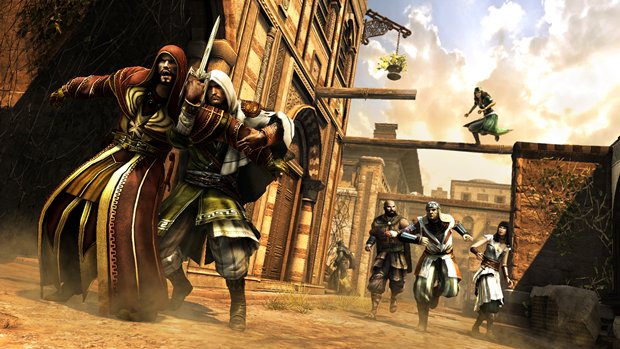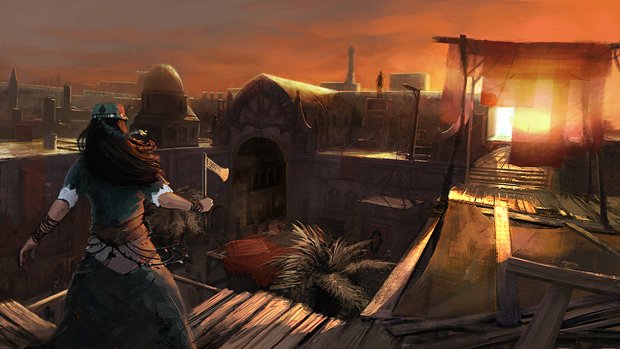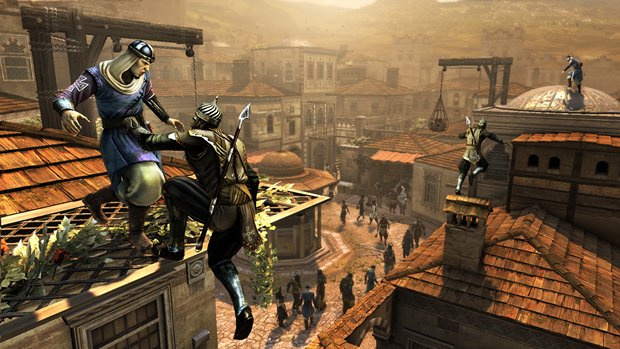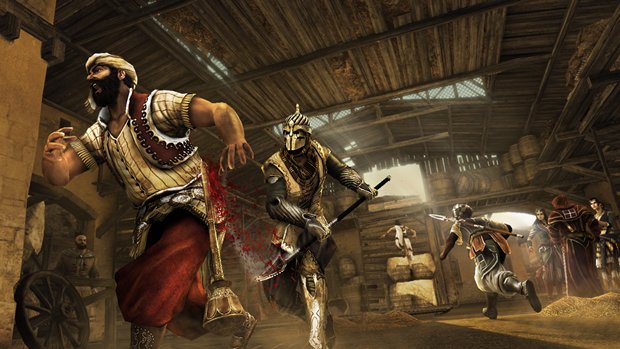Assassin's Creed Revelations hands-on multiplayer preview
New modes, new maps and revamped everything should make stabbing friends in the back even more fun
Assassin’s Creed Revelations multiplayer blowout:Interview with multiplayer director Damien Kieken|
How to kill a games journalist in Assassin’s Creed Revelations|The multiplayer's story revealed
When Assassin’s Creed finally dipped its toes into multiplayer with last year’s release of Brotherhood, the unique new mode – created by Ubisoft’s studio in Annecy, France, best known for their work on Splinter Cell’s spies-vs-mercenaries multiplayer – quickly distinguished itself as one of Brotherhood’s standout features. Favoring a stealth-based approach in which everyone was not-so-secretly hunting everyone else, it was a tense, intimate experience that put crowds, hidden abilities and plenty of climbable Renaissance architecture at players’ disposal.

With Assassin’s Creed Revelations drawing closer to its November release, Ubisoft Annecy isn’t dramatically reinventing AC’s approach to multiplayer, but it has been adding a bunch of new features aimed at making the game even more accessible to new players – and at keeping them hooked once they start. And after experimenting with them firsthand at the Annecy studio, we’re already eager for another round.
Some of the changes are obvious; for starters, there’s actually a complete storyline to follow now, as your Templar operative moves up through the ranks of Abstergo. There’s also been a big push toward customization and implementing more robust community features. And while at first blush Revelations’ multiplayer might look like the same climby, stabby, six-to-eight-player hunt-while-being hunted game we’ve been playing since last year, there have been a lot of significant changes to the gameplay – as well as a new Middle Eastern motif to match the single-player story’s move to Constantinople.

To that end, we saw three new maps – Antioch, Constantinople and Knight Hospital – and played through them as nine new characters, including the Assassin-looking Deacon and Sentinel; the burly, turbaned Bombardier; the masked Renegade; and the toga-wearing Thespian, among others. Of the three maps, two of them – Antioch and Knight Hospital (apparently part of a larger Rhodes map) – were small and intimate, with a few large, open areas that made them perfect for Deathmatch, one of the two new match types we played.
We know, we know – modes called “deathmatch” are usually the antithesis of new. However, Revelations has found ways to make it interesting, positioning it as a faster, more accessible version of Brotherhood’s Wanted match type (which is still in Revelations). Here, some of the more “complex” aspects of Wanted, like the onscreen radar, the chase/escape rules and your opponents’ character models being repeated in the crowd, have been removed. Success, then, comes down to tracking your (unique-looking) prey with an onscreen proximity meter that lights up when they’re in your line of sight.

Once you’re on to your quarry, however, things are a little more complex than they were in Brotherhood. Your approach matters, and depending on how creatively and/or quietly you kill them, you’ll rack up a lot more experience points than you would if you simply ran up and bashed them to death in front of everyone. In fact, if you do that, you’ll likely be at a serious disadvantage; responding to community demands to make the game more balanced for the prey, the developers at Annecy have implemented what’s known as the Contested Kill/Honorable Death system. This means that your prey hits the “stun” button at the same time you hit “kill,” they’ll fight back a bit before you deliver the final blow.
Weekly digests, tales from the communities you love, and more
If you’re the hunter, there are several drawbacks to this. First, your opponent will get points for stunning you, even though he/she is dead. Second, it’ll create a slightly more drawn-out scene likely to draw the attention of your hunter. Third, you’ll stagger around in a helpless, “wounded” state for a few seconds afterward, making you obvious, vulnerable and a prime target for assassination. You’ll still get the kill, of course, but the risk-reward ratio makes it far more worthwhile to kill quietly – maybe from a crowd, with the Poison ability, if you feel like netting a ton of points. However we chose to tackle them, though, the deathmatches were quick, challenging and enormously fun.

Deathmatch wasn’t all we played, of course – we also tried out Artifact Assault, an Assassin-flavored twist on Capture the Flag. The huge, sprawling Constantinople map, with its tight alleyways and huge buildings, proved ideal for this. Here’s how it breaks down: two teams (each sharing the same character type) square off to steal each other’s artifact, located deep in enemy territory. As long as you’re on your team’s side of the map, you’re a hunter, with the task of weeding out enemies (who, of course, are repeated in the crowds) before they can grab your treasure – and, once they do, of chasing them down and killing them before they can make it back to their own base.
Once you’re on their side of the map, however, the game takes on a different dynamic. Here, you’re prey, and you’ll need to make your way to the enemy’s base, steal their (possibly defended) artifact and bring it back to your safe zone. You can take a stealthy approach, hiding in wandering groups of people and using a temporary disguise. You can even be a jerk and wait for a teammate to grab it, then hide nearby while the guards are occupied, wait for the artifact to be returned and then slip out to grab it while nobody’s looking.

Simply tearing ass across the rooftops, grabbing it and making a run for the nearest chase breakers (things like lifts and gates that slam shut behind you) works great, too. In any case, you’re going to have to run once you’ve got the thing, because everyone – friend or foe – will immediately see your location onscreen.



